In fact, 87 percent have raised under $1,000 on Facebook since they began using the platform.
A big part of what holds nonprofit organizations back is the fact that they can’t risk full-fledged social media adoption because they’re short staffed and must focus on creating revenue and running programs — helping real people in the real world.
The post 3 secrets to raising big bucks online appeared first on Socialbrite.
]]>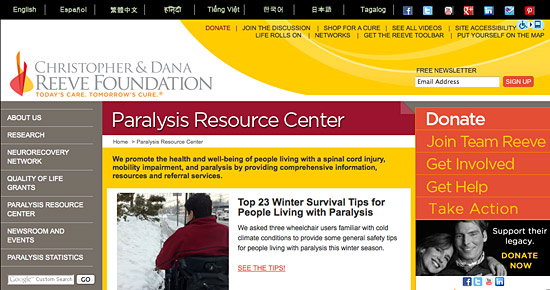
Wide use of social media by the Christopher & Dana Reeve Foundation.
A look at how nonprofits are using social media to fund-raise for social good
Guest post by Frank Barry
Director, Professional Services, Blackbaud
 According to a study by Blackbaud, NTEN and Common Knowledge, over 92 percent of nonprofit organizations have a presence on at least one social networking site, but most raise very little money through their social activity.
According to a study by Blackbaud, NTEN and Common Knowledge, over 92 percent of nonprofit organizations have a presence on at least one social networking site, but most raise very little money through their social activity.
In fact, 87 percent have raised under $1,000 on Facebook since they began using the platform.
A big part of what holds nonprofit organizations back is the fact that they can’t risk full-fledged social media adoption because they’re short staffed and must focus on creating revenue and running programs — helping real people in the real world.
Yet despite the lack of widespread fundraising success, social media is clearly a hot topic in the nonprofit space. Conferences dedicated to helping nonprofits learn how to leverage social media for social good are popping up. Big social fundraising days coupled with workshops and other training events are taking advantage of the groundswell of social fundraising activity. And large online publications like Mashable are even covering social media for social good.
According to Darian Rodriguez Heyman, author of “Nonprofit Management 101” and creator of the Social Media for Nonprofits conference, “In a world where Facebook is the equivalent of the third largest country on the planet, we have to ask ourselves, ‘How can nonprofits leverage the immense word-of-mouth potential that social media makes available to causes both large and small?’ Nonprofit leaders need practical tips and tools for fundraising, marketing, and advocacy if they are to maximize impact online and in general.”
So what is holding nonprofit organizations back and how are the top 1 percent succeeding? It’s clear from the data below that three big things contribute to the lack of fundraising success: 1) lack of budget, 2) lack of staffing, and 3) lack of focus on raising money.
Social media adoption by platform
Heading into 2011, most nonprofits (92%), regardless of organization size, are using at least one commercial social network like Facebook, Twitter or LinkedIn.
The industry giant, with 89% adoption among nonprofits, is Facebook. Twitter is the second most popular, used by 57% of organizations, with YouTube, LinkedIn and Flickr rounding out the top five.
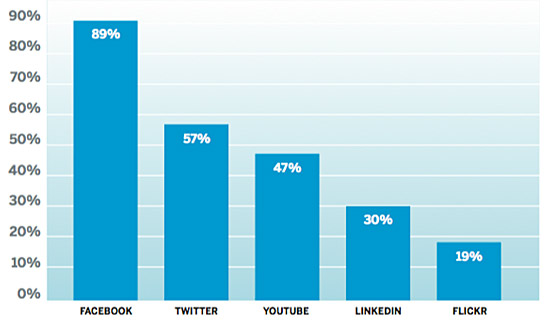
Social media adoption by budget
More than half (52%) of nonprofits have no formal budgets for social networks with just 4% allocating more than $50,000 annually.
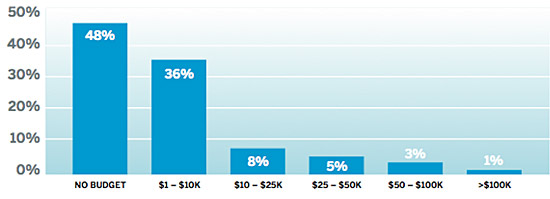
Social media adoption by staffing
On the staffing side, 86% of nonprofits commit some employee time to social networks, with the majority (61%) allocating a quarter of a full-time employee, and nearly 15% dedicating three-quarters or more of a full-time staffer.
But if you look closely you’ll notice that 86% of nonprofits commit one-half or less of a full-time staffer.
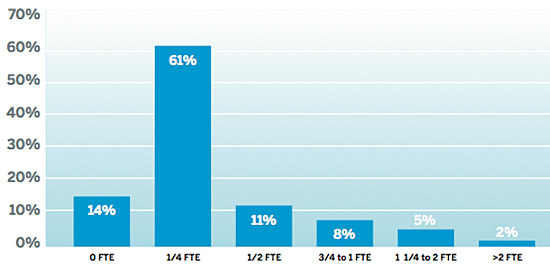
Social media adoption by fundraising
Fifty-eight percent of nonprofits report measuring at least the soft benefits — e.g., increased awareness, education, non-financial supporter participation — of their commercial social networks. Just 9 percent measure return on investment (ROI), or revenue received from donors, sponsors, advertisers, etc.
It’s important to note that 35 percent have raised less than $1,000, and a very thin slice of less than 1 percent of all nonprofits have raised more than $100,000 via Facebook in the past year.
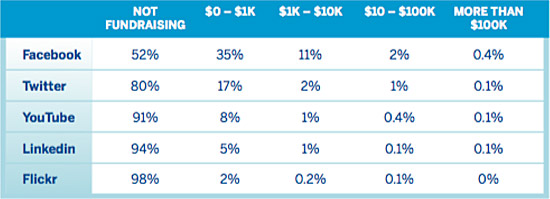
How are the top 1% achieving success?
The numbers are interesting and all, but what’s the thing that separates those top 1 percent performers from the rest of the pack? And how can any nonprofit, large or small, put big numbers on the board?
The answer is as simple as 1, 2, 3. Here are three ways for nonprofits to raise big dollars online:
1) Hire or assign someone currently on staff. Nothing good can happen if no one’s working on it. It’s a pretty logical bit of reasoning, but judging by the data, nonprofits don’t allocate much staff time to social media.
Take a look at organizations like Make-a-Wish Foundation, Best Friends Animal Society, Christopher and Dana Reeve Foundation, American Red Cross, National Wildlife Federation, Humane Society and March of Dimes. Every one of these nonprofits has at least one person on staff that owns their social media program. Some even have full-blown teams. If you’re trying to leverage the social Web and all it has to offer, at some point you’re going to have to put resources on the job.
2) Allocate budget. We all know you have to spend money to make money. Nonprofits spend money on direct mail, email, websites, big events, and much more as part of their fundraising strategy. None of it is free, so why would the effective use of social media be any different?
Those who are finding social media to be an effective fundraising channel spend money on things like custom Facebook pages, Facebook ads, Facebook apps, promoted tweets, professional social media engagement platforms, blogs, content creation, campaign integration and much more. It doesn’t have to be an enormous amount of money, but if you want to raise significant dollars, you have to invest.
3) Add social media components to your fundraising appeals. Now that you’ve put someone in charge of your social media use and allocated some budget, it’s time to get to work, but instead of blowing things way out of proportion, start thinking of ways to incorporate social media into your existing fundraising efforts.
You probably have an end of year fundraising appeal that you distribute through direct mail, email and your website, right? Why not get creative this time around and use Facebook to generate two-way engagement in the form of people sharing why they support your organization, Twitter to tell the masses and YouTube to create a personalized thank-you video for all those who donate?
The key is to infuse your current fundraising activity with social media rather than try to dream up a totally new way of raising money.
Conclusion: Do these 3 things and thrive! Agree or disagree? Please share in the comments.
 This work is licensed under a Creative Commons Attribution-NonCommercial 3.0 Unported.
This work is licensed under a Creative Commons Attribution-NonCommercial 3.0 Unported.
The post 3 secrets to raising big bucks online appeared first on Socialbrite.
]]>The post HelpAttack!: Unleash the charitable power of social media appeared first on Socialbrite.
]]>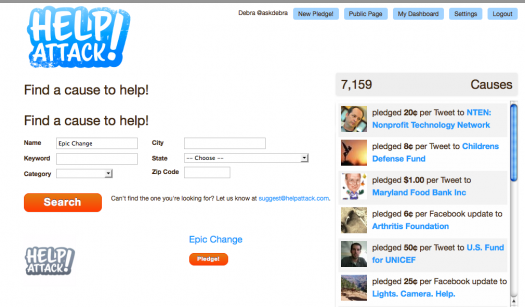
Social fundraising tool for nonprofits turns messages into donations
Guest post by Ehren Foss
CEO, HelpAttack!
 Nonprofits may be interested in what HelpAttack! brings to the social fundraising party. When a donor uses HelpAttack!, each tweet or Facebook update can be a donation, with no need to tag, re-post or change your habits as a donor. It’s a way to seamlessly add giving to your online life.
Nonprofits may be interested in what HelpAttack! brings to the social fundraising party. When a donor uses HelpAttack!, each tweet or Facebook update can be a donation, with no need to tag, re-post or change your habits as a donor. It’s a way to seamlessly add giving to your online life.
![]() HelpAttack! was the brainchild of Sarah Vela, David J. Neff and myself. Everybody was asking Sarah to donate, and before long she was saturated with asks. What if, she thought, the message itself – the tweet, the donation link, the uploaded photo of a proto-mustache – was the donation?
HelpAttack! was the brainchild of Sarah Vela, David J. Neff and myself. Everybody was asking Sarah to donate, and before long she was saturated with asks. What if, she thought, the message itself – the tweet, the donation link, the uploaded photo of a proto-mustache – was the donation?
Her idea was simple: a penny a tweet could be donated to your favorite nonprofit or cause, no matter what the tweet is about. No need to tag, retweet or change your social media habits in any way. And a more harmonious, slightly less spammy Twitterverse.
Since its initial rollout, HelpAtack! has expanded on that original idea. HelpAttack! has added Facebook pledges and features for cause organizations to create their own page and messaging. Recently, we added a few additional types of pledges: You can now give when someone else tweets or when hashtags and other terms appear on Twitter. Simply decide which organization will receive your donations, assign a donation amount per tweet or Facebook update (or assigned hashtag or term), a maximum donation amount and tweet or update, away.
A simple process to begin raising funds for your cause
HelpAttack! has 7,195 nonprofits for people to choose from in our database, and as of today, 163 distinct nonprofits have received donations, totaling $15,510. We currently have about 900 users. To get started, there’s a simple sign-up process:
- Go to helpattack.com.
- Add the HelpAttack! Twitter or Facebook app via the giant buttons.
- Choose a cause (or ask us to add your favorite).
- Set a limit for your giving and an amount per update.
- We’ll email you a couple times to let you know how it’s going. That’s it!
Does it make you tweet or Facebook less? HelpAttack! donors frequently tell us they make more updates rather than fewer, hoping to reach a certain level of giving (“three more tweets to $25!”). In addition, many donors choose to share their pledges with their networks on Twitter and Facebook. For example, from 35 original pledges, the American Red Cross has grown to more than 500 total pledges and more than $12,300 pledged through its fan base sharing and donating. You can read more in our April case study, and also one with the Best Friends Animal Society.
The Arthritis Foundation, DonorsChoose, U.S. Fund for UNICEF and other causes have also tried HelpAttack! and found success within their communities. HelpAttack! partners with First Giving to process the donations, and a total of 8.25% goes toward credit card fees, our partners and running our service. HelpAttack! priced it this way – with no fees per sign-up, no monthly cost or transaction fee – so that our goals (donations, awareness, effectiveness) align with those of the nonprofit.
Tips on how to best use the service
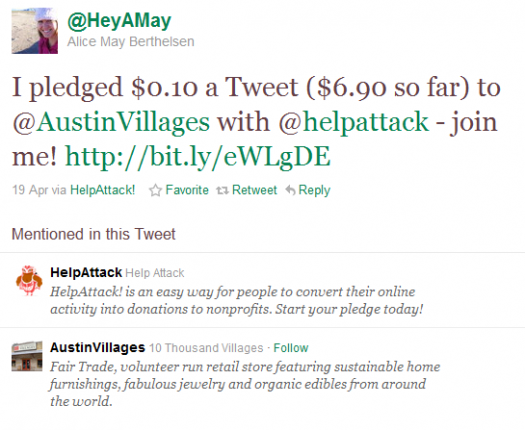
Here are some quick tips on how to best use the platform:
- If you only have a few hundred supporters on Twitter and Facebook, work to build and strengthen those communities first.
- Also, if you haven’t ever posted a link to your regular donation page on social media, give that a whirl! People want to give. Ask them and make it easy.
- Sign up and make one tweet or Facebook update about HelpAttack! It’s free, try it! Rather than spending a month crafting a campaign, just see how your community responds, measure, iterate and go from there.
What else could be more social than giving by just tweeting or updating your Facebook status? If you’re curious, have questions or are interested in mixing it up with matching funds, cause marketing, employee giving or anything at all, just let us know!
Fundraising series on Socialbrite
• What social fundraising means for your nonprofit
• Social fundraising tools: Our top 5 picks
• Fundly: Tap into your supporters’ social networks
• GoodThreads: Custom T-shirts as a fundraising tool
• HelpAttack!: Unleash the charitable power of social media
• Rally: Raise money for your favorite cause
• Mobile: The next frontier of nonprofit fundraising
• 10 tips for a successful fundraising event
The post HelpAttack!: Unleash the charitable power of social media appeared first on Socialbrite.
]]>The post How to create love online: To Mama with Love appeared first on Socialbrite.
]]>Honor your mom by supporting schools & women’s shelters abroad
With Mother’s Day just around the corner, let’s give props to To Mama With Love, a collaborative online art project that honors moms across the globe and raises funds to invest in remarkable women who are transforming our world. An initiative of Epic Change, the folks behind Tweetsgiving, To Mama With Love is simply about creating and spreading love.
In the grassroots effort, which runs through Sunday — Mother’s Day — participants create socially shareable “heartspaces” that include words, videos, photos and investments in honor of mamas they love. The change-makers are four incredible women who have created schools and shelters for children who face poverty, illiteracy, and lack of opportunity in Nepal, Afghanistan, and Tanzania. Epic Change’s goal this year is to raise at least $65,000 to invest in Mama Lucy’s secondary school in Tanzania; Renu and Maggie’s schools in Kathmandu & Surkhet, Nepal, and Suraya’s women’s shelter in Afghanistan.
To Mama With Love is a social media fundraising campaign, and it has been designed carefully for success. Epic Change has taken every principle of great community organizing and integrated it into To Mama With Love. If you want to run a successful social media fundraising campaign, you can’t do better than to follow their lead. Here’s how:
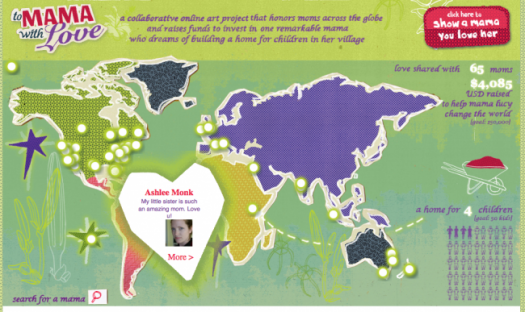
6 tips for running a successful social media campaign
1. Cultivate a community of stakeholders. Stacey Monk, Epic Change’s founder, is a gardener. She has spent years planting seeds of love and cultivating a community of giving. She cultivates the “magic middle” of stakeholders, activists, and influencers who would genuinely care about a cause such as Epic Change’s.
2. Nurture leaders. This year, Epic Change created a private Facebook Group to discuss the campaign before launch. Stacey invited people into the group that she’s been cultivating for years (and who have shown interest in Epic Change). Then she nurtured them.
- She asked people to introduce themselves within the group.
- She asked for volunteers to help with tasks (proofing the press release, developing a Twitter list, inputting a database list, etc.).
- She asked people to invite their friends into the group, and welcomed those friends as they joined.
- Stacey created questions within the private group to bring out our expertise: a win-win for all.
3. Create campaigns with your stakeholders. Stacey consistently asked the group for help refining the campaign. She asked questions such as whether we send the blogger invitations during the weekend or not, should she redesign the home page in a certain way, and when should people tweet? She listened and followed the group’s consensus.
4. Be transparent and inclusive. Campaign documents are posted for all to view and comment upon. Questions are encouraged, and comments are invited.
5. Design commitment. Before joining the group (or upon joining), we were asked to commit to at least one “mission,” which we committed to through a form. Missions included: Invite five others to join the group, commit to writing a blog post, commit to donating money during the campaign, create a heartspace, send emails, and “nudge an influencer.” Stacey sends out mission reminders and asked us to post which missions we completed to the private Facebook Group.
6. Recognize those who are giving. The To Mama With Love website recognizes the bloggers, donors, and the volunteers who helped to plan the event very publicly. This is the very the community that Epic Change has spent the time cultivating.
One other thing: When I volunteered to help out with Epic Change’s Tweetsgiving 2010 campaign, Stacey Monk personally called me at home to thank me the night before the launch. In doing so, she instantly created a more personal, stronger offline connection out of our online connection, strengthening the connection.
Stacey has created a family you want to be part of, one that supports each other and offers collaboration and encouragement … en route to changing the world.
This is a cause I believe in tremendously, and it aligns with my vision of creating a just world of opportunity. My mother was one of the 1970s-era equal rights activists who marched, protested, fought for an equal rights constitutional amendment, attended a world conference on women, and put her money where her mouth was to fund Emily’s List. I’m honoring my mother, Susan Silverman Askanase, in my heartspace.
To create your own heartspace and honor a mama you love, go to http://www.tomamawithlove.org
 This work is licensed under a Creative Commons Attribution-NonCommercial 3.0 Unported.
This work is licensed under a Creative Commons Attribution-NonCommercial 3.0 Unported.
The post How to create love online: To Mama with Love appeared first on Socialbrite.
]]>The post $100,000 in three days: How #TeamAutism did it appeared first on Socialbrite.
]]>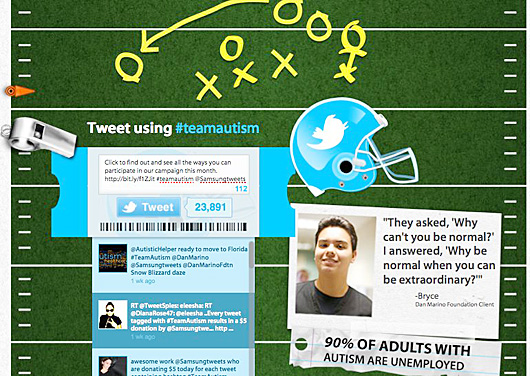
Guest post by Amy Sample Ward
amysampleward.org
Earlier this month, Samsung Hope for Children, the national philanthropic initiative of the Seoul-based tech company, and the Dan Marino Foundation launched a new social action campaign, “Team Up for Autism,” in conjunction with the first annual WalkAbout for Autism organized by the foundation started by the former Miami Dolphins quarterback. The initiative set about to help raise awareness and funding in support of medical research, services and treatment programs for children with autism.
Samsung pledged to contribute up to $100,000 through this social action challenge, providing a donation of $5 to the Dan Marino Foundation each time someone pledged their support of autism awareness by sharing an infographic with their Facebook friends or sending a tweet with the hashtag #teamautism. And in just 72 hours, they reached their goal of $100,000 through TeamUpForAutism.com.
That’s a whole lot of donations in just three days! So, I connected with Sloane Berrent, founder of The Causemopolitan and a partner in Socialbrite, to learn more about this success story. She’s working with the creative agency JESS3 on this entire campaign. They created the infographic and pulled her in for the overall digital strategy.
Going into the campaign, did you really expect to hit your goal in just three days? What were the goals and expectations you had set for the campaign internally?
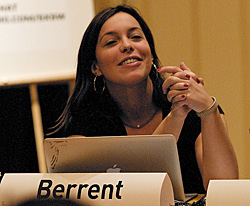
That said, this time around, Samsung, the Dan Marino Foundation and JESS3 were looking for more bite. The goal was $100,000 and we were given a month but were definitely hoping for two weeks. It was absolutely amazing to reach our goal so quickly, and it’s because of all of the hard work we did beforehand that it happened. That and a bit of groundswell.
What kind of post-campaign planning did you do before launching?
Sloane Berrent: We really focused on building our team of advocates before we launched the campaign. I know a lot of campaigns where people feel that you launch and put it out there and then you bring people in and have them share in the experience. But for this campaign we really baked them in early. We contacted autism advocates and let them know this campaign was coming.
We didn’t have all the pieces finished, but we drafted outreach and pulled together lists. It’s really important to be prepared when you hit the gate. Sometimes campaigns change when they’re live and that hard work you put in gets discounted and sometimes it makes all the difference. It’s not a gamble, though. You have to do the work, identify your target groups and know who your advocates are. You have to pay attention to what happens in that first 24 hours and be willing to change your strategy to fit what the market is telling you because you never really know what’s going to happen with a campaign until it’s live.
How do you see the social media engagement and outreach involved in this campaign impacting the post-campaign social media use by the Foundation?
Sloane Berrent: We really worked on educating Dan Marino and the Dan Marino Foundation on how to effectively use social media. They both were aware of what was out there, but we talked a lot about engagement and creating conversation. Both have seen a rise in their numbers of followers and fans and sometimes that quantity helps to get to quality. I don’t think nonprofits should have to fight tooth and nail for every follower. Spikes like this campaign are good for nonprofits, and then they can back into these tools and find a way that works for their bandwidth on a day-to-day basis.
To others looking at your success as an inspiration for their own campaigns and fundraising plans, what tips or recommendations would you share?
Sloane Berrent: Thank people one time too many. I’m serious! Say thank you and then say thank you again. That’s a bit of secret sauce but you can never say thank you enough to people who do things for you because they want to and not because they’re paid to or work for you. That’s a powerful change agent.
It’s like the idea of second gifts. Someone makes a gift, they get a thank you and then they make a second gift because they were impressed with the thank you. It’s a cycle. When people feel recognized and valued, truly valued, they are willing to go to bat for you. Social media is complicated and wily at times, sometimes you’re the hare and sometimes you’re the tortoise. But the key is bringing your supporters along with you to your next campaign. Then success will follow you because people love being a part of not only your cause but the feeling they get from helping your cause.
Other campaigns: Lessons to share?
Has your organization looked to partner with another organization or a company for a campaign the way the Dan Marino Foundation partnered with Samsung, with dedicated matching funds? Have you tried a Twitter campaign with donations per tweet? What lessons would you share – what questions would you like to ask Sloane?
Republished from amysampleward.org.
The post $100,000 in three days: How #TeamAutism did it appeared first on Socialbrite.
]]>